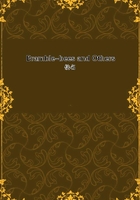
第97章 THE HALICTI: PARTHENOGENESIS.(6)
True, it may be said that the second progeny is due to the mothers who knew the males in autumn and who would be able to nidify twice a year. The suggestion is not admissible. The Zebra Halictus confirms what I say. She shows us the old mothers no longer leaving the home but mounting guard at the entrance to the burrows. No harvesting- or pottery-work is possible with these absorbing doorkeeping-functions.
Therefore there is no new family, even admitting that the mothers'
ovaries are not depleted.
I do not know if a similar argument is valid in the case of the Cylindrical Halictus. Has she any general survivors? As my attention had not yet been directed on this point in the old days, when I had the insect at my door, I have no records to go upon. For all that, Iam inclined to think that the portress of the Zebra Halictus is unknown here. The reason of this absence would be the number of workers at the start.
In May, the Zebra Halictus, living by herself in her winter retreat, founds her house alone. When her daughters succeed her, in July, she is the only grandmother in the establishment and the post of portress falls to her. With the Cylindrical Halictus, the conditions are different. Here the May workers are many in the same burrow, where they dwell in common during the winter. Supposing that they survive when the business of the household is finished, to whom will the office of overseer fall? Their number is so great and they are all so full of zeal that disorder would be inevitable. But we can leave this small matter unsettled pending further information.
The fact remains that females, females exclusively, have come out of the eggs laid in May. They have descendants, of that there is no room for doubt; they procreate though there are no males in their time.
>From this generation by a single sex, there spring, two months later, males and females. These mate; and the same order of things recommences.
To sum up, judging by the three species that form the subject of my investigations, the Halicti have two generations a year: one in the spring, issuing from the mothers who have lived through the winter after being fecundated in the autumn; the other in the summer, the fruit of parthenogenesis, that is to say, of reproduction by the powers of the mother alone. Of the union of the two sexes, females alone are born; parthenogenesis gives birth at the same time to females and males.
When the mother, the original genitrix, has been able once to dispense with a coadjutor, why does she need one later? What is the puny idler there for? He was unnecessary. Why does he become necessary now? Shall we ever obtain a satisfactory answer to the question? It is doubtful. However, without much hope of succeeding we will one day consult the Gall-fly, who is better-versed than we in the tangled problem of the sexes.
INDEX.
Alpine Odynerus.
Amadeus' Eumenes.
Ammophila (see also Hairy Ammophila).
Andrena.
Andrenoid Osmia.
Ant.
Anthidium (see the varieties below, Cotton-bee, Resin Bee).
Anthidium bellicosum.
Anthidium cingulatum (see Girdled Anthidium).
Anthidium diadema (see Diadem Anthidium).
Anthidium florentinum (see Florentine Anthidium).
Anthidium Latreillii (see Latreille's Resin-bee).
Anthidium manicatum (see Manicate Anthidium).
Anthidium quadrilobum (see Four-lobed Resin-bee).
Anthidium scapulare (see Scapular Anthidium).
Anthidium septemdentatum (see Seven-pronged Resin-bee).
Anthocopa papaveris (see Upholsterer-bee).
Anthophora (see also Anthophora of the Walls, Hairy-footed Anthophora, Masked Anthophora).
Anthophora of the Walls.
Anthophora parietina (see Anthophora of the Walls).
Anthophora pilipes (see Hairy-footed Anthophora).
Anthrax (see Anthrax sinuata).
Anthrax sinuata.
Aphis (see Plant-louse).
Archimedes.
Augustus, the Emperor.
Bee.
Beetle.
Bembex.
Black, Adam and Charles.
Black Plant-louse.
Black Psen.
Black-tipped Leaf-cutter.
Blue Osmia.
Book-louse.
Brown Snail.
Bulimulus radiatus.
Bumble-bee.
Calicurgus (see Pompilus).
Capricorn.
Carpenter-bee.
Cat.
Cemonus unicolor.
Cerambyx (see Capricorn).
Ceratina (see also the varieties below).
Ceratina albilabris.
Ceratina callosa.
Ceratina chalcites.
Ceratina coerulea.
Cerceris.
Cetonia.
Chaffinch.
Chalicodoma (see Mason-bee).
Chrysis flammea.
Cockroach.
Coelyoxis caudata.
Coelyoxis octodentata.
Colletes.
Common Snail.
Common Wasp.
Cotton-bee (see also the varieties of Anthidium).
Crayfish.
Cricket.
Crioceris merdigera (see Lily-beetle).
Cryptus bimaculatus.
Cryptus gyrator.
Cylindrical Halictus.
Darwin, Charles Robert.
Decticus verrucivorus.
Devillario, Henri.
Diadem Anthidium.